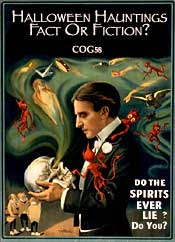
We left Ohio Wednesday morning and headed down for Washington D.C.
The weather held and so we got some great views of the countryside as
we traveled down through the state, the across part of Pennsylvania and
into West Virginia, Maryland, and Virginia. I believe we went through
Cumberland along the way so we were reversing the route taken by
many of the settlers that headed west 200 years ago. We saw some more
live deer along the way (including a very young one very close to the
highway).
I have to confess to being pretty vague about the routes we took on the
entire trip. In the old days I'd might have been looking at a map, but
while we had maps with us, the GPS device did all the navigating. My
main duty as navigator was to point out the upcoming exit to Cheryl.
And the GPS sure came in handy several times, such as when we
reached the D.C. Beltway and the daily rush hour traffic jam later
Wednesday afternoon.(although the female British voice sounded
very peevish with us when we ignored some direction. She sounded
as if she was flicking a whip or tapping a riding crop as she snapped
"Ree-calculating!"
We reached our hotel around 7pm and perhaps the less said about it, the
better. Although it wasn't a horrible place, it was not close to a restaurant
and the commuter train rain right behind the building. I was a bit worried
about leaving anything in the car so I transferred my birthday gifts into
my backpack, using my genealogy binder and Pop's old license plate to
protect the family bible. We ordered out for pizza instead of trying to find
a restaurant.
Our plan the next morning was to visit the World War 2 and Vietnam War
memorials but we couldn't find a place to park, so we decided to visit
Arlington National Cemetery instead, taking one of the guided tours that
leave from the visitor's center. We chose the one that included President
Kennedy's grave, the Tomb of the Unknown Soldiers and Arlington House
which was Robert E. Lee's home. It's a sobering and moving experience
to see the graves of so many Americans who have died in service to our
country. The Changing of the Guard at the Tomb of the Unknown Soldiers
was especially impressive.(even though one person forgot to shut off their
cellphone and chose to answer it rather than hit "mute". Luckily the
ceremony was already drawing to a close when the phone rang.)


(these two photos were taken by Cheryl)
Cheryl had told me she'd made reservations for lunch at some spot in D.C.
for one o'clock so we drove back downtown. We found a parking garage
and I took my backpack along because I wasn't about to leave the West
family bible in the car. Then we walked a few blocks to the Old Post
Office building, where we had to go through a metal detector and I told the
guards there was an old license plate in the bag that might set off the
alarm. (We'll get back to that backpack later). As we went further into the
building I could see there was a food court two flights of stairs down from
street level, which didn't thrill me because of a) my sore knee and b) as I've
said before, I hate stairs.
When I finally made it to the bottom, I started getting suspicious. My sister
was looking around, she said, for the restaurant and then she tried to call
somebody. Finally Cheryl suggested we just get some food and we picked
out a table at the back of the food court. And while I was in line getting a
sandwich, the second birthday surprise of the trip arrived. Stacy is a good
friend of 11 years of roleplay and she and Cheryl had been planning this
for a bit. It was nice to finally meet her in person (although I wish I'd
known so I could have dressed better!) and we had a good conversation
about our online friends and our real life families for a few hours as we
ate lunch. Stacy's just as classy face to face as she is online and the visit
went by too fast.

After we said our goodbyes, Cheryl and I made our way back to the car
and started the trip home. We thought we'd make it back to Massachusetts
by late that night or early Friday morning, but we didn't count on the
rear end fender-bender in Baltimore or the heavy rainstorms that finally
forced us to spend one more night in a motel in New Jersey, where I
realized that besides the family bible and license plate, my backpack
also contained the steak knife Gary and Dian had given me. I still can't
figure out how that wasn't spotted in the x-ray machine at the Old Post
Office, but on the other hand, I'm glad we didn't have an incident!
We finally arrived home Friday afternoon. It had been a good trip through
9 states and the District of Columbia. I had the chance to see Aunt Dot
and my cousins Diana, Louise and their husbands Gary and Steve, and then
to meet Stacy in Washington. I saw some beautiful country, spent some
quality time with my sister, and I've developed a liking for the music of
Toby Keith.
All in all it was a great time and my thanks once again to everyone,
especially Cheryl, for making it so!









